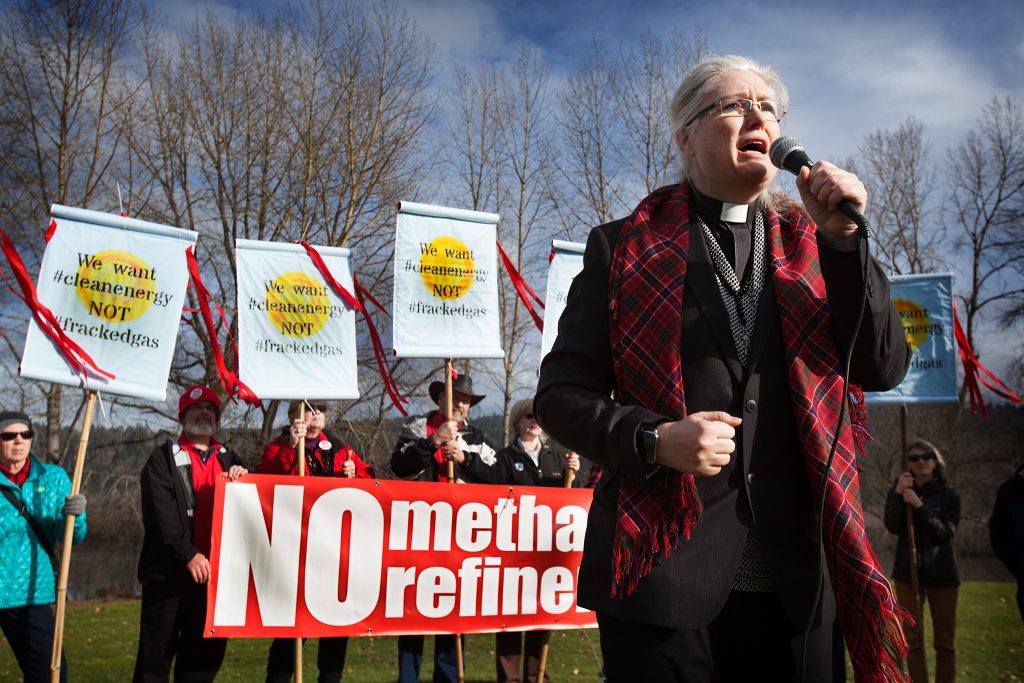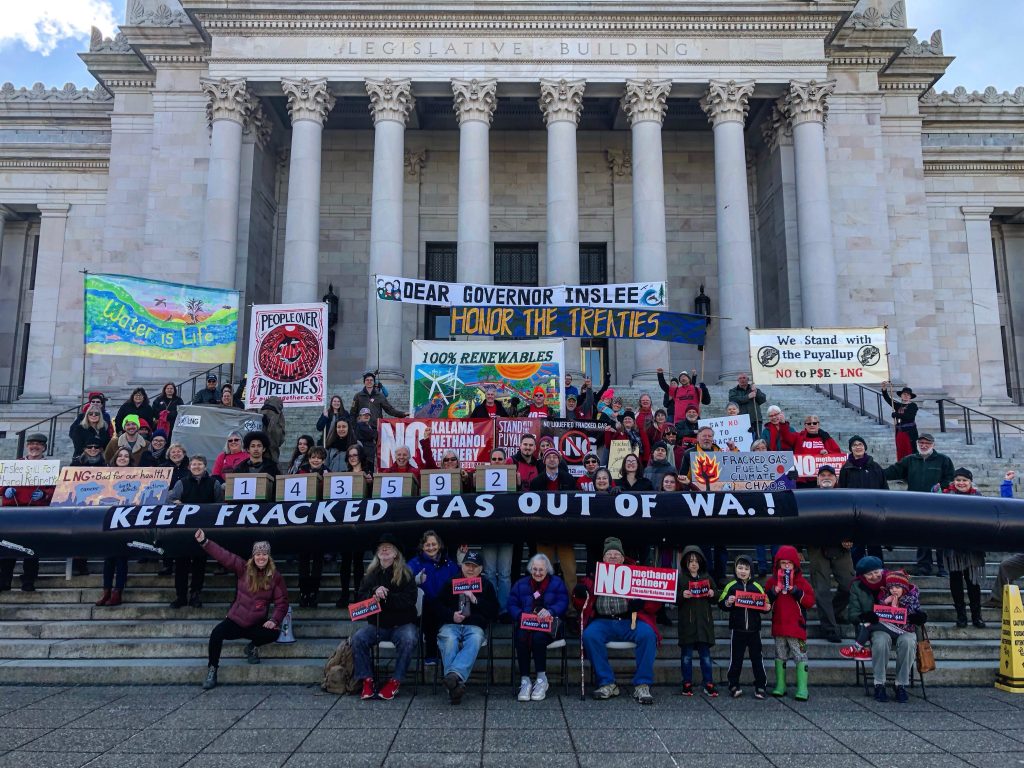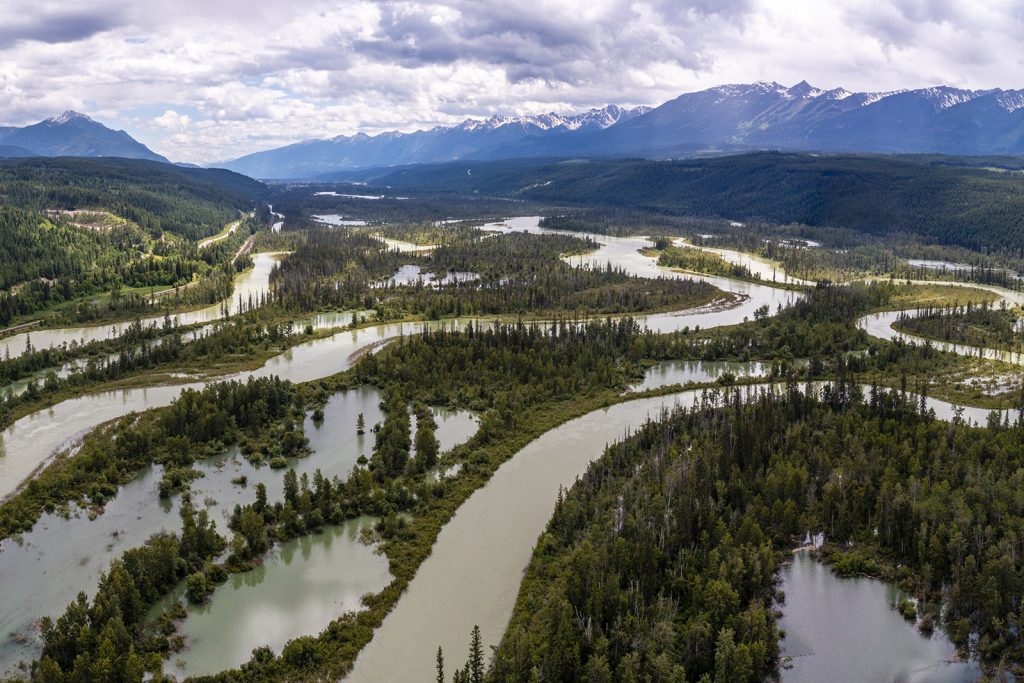By Tina Lassen, Guest Author
Originally published in Columbia Riverkeeper “Currents” Issue 1, 2025
“You must listen to people on the frontlines,” urged the late Elizabeth Furse, a tireless activist and three-term Congresswoman instrumental in the formation of Columbia Riverkeeper. Founded on Earth Day, 2000, Columbia Riverkeeper brought together local advocacy groups—notably Columbia River United and Clean Water Columbia—to create one united nonprofit voice to protect and restore the Columbia River we cherish.
For 25 years now, Columbia Riverkeeper has heeded Furse’s advice. This organization is rooted in frontline activists writing letters, rallying neighbors, and working in solidarity with Tribal Nations.
“I’m so proud of what this organization has accomplished,” says former executive director Brett VandenHeuvel. “Columbia Riverkeeper uses legal tools to level the playing field against big corporations and we tap into the power of the people trying to protect places they love. Against all odds, we’ve had a huge string of successes.”
On our 25th anniversary year, let’s take a peek back at some of the highlights and celebrate what we have accomplished together.
2000-2005: Getting started, grassroots style
In the early days, Riverkeeper rallied around an obvious goal: clean water in the Columbia. The organization launched a patrol boat to catch polluters firsthand. When the paper and pulp industry pressured the Oregon Dept. of Environmental Quality to weaken protections related to water clarity, Riverkeeper and its allies argued—and won—to protect clean water.
Shortly thereafter, we began monitoring water quality, thanks to volunteers trained to sample for bacteria. Today, data collected by our water quality technicians is available on the Swim Guide app, giving users the knowledge they need to swim, fish, and enjoy the river without fear of getting sick.
2005-2010: Racking up wins against fossil fuels
Liquified natural gas (LNG) emerged as a huge threat in the early 2000s. Developers such as Bradwood Landing LNG and Oregon LNG set their sights on the Lower Columbia, where they intended to dredge the fragile estuarine ecosystem—destroying vital habitat for threatened salmon—to build large tanker terminals that, according to the LNG companies, would receive, convert, and distribute imported fracked gas. And, they would need pipelines to do it: this brought together a courageous cross-section of rural community members to oppose the disproportionate harm on people near the proposed pipeline corridors.
Columbia Riverkeeper went to work, and soon was at the forefront opposing these disastrous plans. We stood with Tribes, fishers, farmers, and inspiring community activists. And it worked! Bradwood LNG’s developer filed for bankruptcy in 2010. Our little nonprofit realized we could do this, powered by our expertise in environmental laws and regulatory processes, and the partnership of passionate community members and the leadership of Tribal Nations. The signature victory over Bradwood LNG set the tone for future fossil fuel campaigns—including Oregon LNG, rejected a few years later.
At the same time, we were strengthening our bonds with Columbia River Tribes, invaluable relationships that have only deepened over the years. We collaborated on efforts to improve Oregon’s toxic water pollution standards, which ignored the above-average rates of fish consumption by Tribal members. Columbia Riverkeeper joined the Columbia River Inter-Tribal Fish Commission and the Confederated Tribes of the Umatilla Indian Reservation in workgroups to address the injustice in the established rate and lobby for new standards. Years of work led Oregon to adopt the nation’s most protective toxic pollution standards—and cleaner, healthier water for all.
2010-2015: Polluters get bigger, so do our victories
By 2010, Columbia Riverkeeper was really hitting its stride. We pushed back on numerous proposals for refineries and export terminals along the Columbia that would only deepen dependence on fossil fuels. One of the most egregious was the Port of Columbia County’s attempt to rezone 837 acres of prime, productive farmland for industrial use—a key step in turning the Lower Columbia into a fossil fuel hub. Thankfully, we fought back and successfully used Oregon’s land use laws to protect farms, fish, human health, and the climate. The threat remains, but we have a long track record of success.
None of the proposals loomed larger than the one envisioned for Longview, WA, in 2012. Millennium Bulk Terminals would have been the largest coal export terminal in North America, with catastrophic impacts on the region’s water and air quality. As Columbia Riverkeeper rallied with Tribes, allies, and local communities, we also discovered and exposed plans for a massive crude oil refinery in Longview, a project that would belch carcinogens and neurotoxins just a quarter mile from homes and businesses.
Columbia Riverkeeper began what would be six years of grinding through meetings and court hearings, supporting and building strength together with residents who wanted to protect the health of their families and neighbors from dirty industries and act on the climate crisis. At the same time, in partnership with a coalition of nonprofits, we celebrated a legal victory to shut down Oregon’s last coal-fired power plant in Boardman. The Boardman plant was closed, and both Longview plans were ultimately defeated, as well.
2015-2020 The nation takes note
Nasty old coal and crude oil continued to demand our attention. In 2016, they captured the nation’s attention, too, when a train transporting crude oil derailed in the riverfront town of Mosier, OR, sending plumes of black smoke into the skies and oozing its toxins into the ground and threatening to leak into nearby Rock Creek, an adjacent wetland, and the Columbia River. Our advocacy on the dangers of oil-by-rail suddenly was making national headlines. Government leaders and concerned communities took note. By 2018, the proposed Tesoro Savage oil train terminal in Vancouver was defeated—and so was the nightmare of oil trains and tankers that would have supported the nation’s largest oil-by-rail terminal.

Yet proposals kept popping up. The 2015 Perennial Power fracked gas power plant in Hermiston would have been one of the largest climate polluters in Oregon. But you and Columbia Riverkeeper and allies kept pushing back. Soon Perennial went the way of Tesoro, Millenium, fracked gas-to-methanol plants in Kalama and Columbia County, and so many others. Together, we’ve kept millions of tons of carbon—and the irrevocable harm it causes—out of the atmosphere. Defeating fossil fuel infrastructure means defeating future decades of climate destruction. Instead, Columbia River communities are looking ahead to a cleaner renewable energy future.
Meanwhile, the federal government also needed to clean up its act. Hydroelectric dams operated by the Army Corps and Bureau of Reclamation routinely discharge oil and other pollutants into the Columbia and Snake rivers, in clear violation of the Clean Water Act. But federal agencies aren’t above the law. For more than a decade, we took these powerful entities to court, demanding that they reduce their flagrant illegal pollution, obtain the required permits, and switch to less harmful oils in dam equipment. We won big multiple times, curtailing oil leaks at 10 federal dams—victories the Wall Street Journal called “groundbreaking.”
And oil pollution wasn’t the only problem. The dams are a leading culprit of elevated river temperatures, with devastating effects on salmon. Case in point: in 2015, 96 percent of endangered Snake River sockeye died because of hot water in the Lower Snake and Columbia. Along with allies, we took the EPA to court, demanding changes and fighting for the salmon’s survival. It would continue to be a top priority for years.
2020-2025 Cleaner air, cleaner water, invaluable coalitions
For more than two decades now, we have been making progress on protecting and restoring the Columbia. In 2023, positive feedback came in the form of a settlement Columbia Riverkeeper reached with the Port of Vancouver, which required the port to spend over $25 million to reduce dangerous levels of copper—highly toxic to salmon—and other unlawful pollution seeping from its industrial property into the Columbia.
The Army Corps’ long legacy of industrial pollution around Bonneville Dam was so bad the area was named a Superfund site in 2024, following decades of leadership and advocacy by Yakama Nation, and support from Columbia Riverkeeper. We are privileged to partner with Tribes to ensure swift, effective cleanup for those who depend on clean water and healthy fish to sustain their livelihoods and cultures.
Earlier efforts involving mismanagement at the dams are also coming to fruition: Multiple federal agencies have been ordered to develop sound solutions for reducing heat pollution. If they continue to resist meaningful change, we’ll continue to push for meaningful actions that lead to cleaner, healthier waterways abundant with fish.
Along with Columbia Riverkeeper’s commitment to advocacy and action, we’ve enjoyed expanding our community outreach, educating youth, and nurturing the next generation of advocates. We’ve partnered with Yakama Nation for years on the complexities of Superfund cleanup at the Hanford Nuclear Site and are particularly honored to join them with programs at local schools and with events like the annual Hanford Journey. In 2020, we became a fiscal sponsor of Communidades, a Latino/a/x-led environmental group in the Gorge, which became an independent organization in 2024. And every year we engage thousands of students in Columbia River communities.
“I’m confident Columbia Riverkeeper will continue to secure victories for clean water, salmon, and the communities that depend on them for years to come,” reflects Board President Emily Washines (Yakama). “I hope 25 years of victories, of people whose only connection might be coming together for the Columbia, will inspire more engagement and support than ever.”
We can’t do it without you—and together, we can’t wait to do more.

Tina Lassen writes about outdoor recreation and environmental issues for several national publications and websites, and is at work on a guidebook about watching wildlife in North America. She has lived happily in Hood River for more than 20 years and is a longtime Columbia Riverkeeper supporter.

